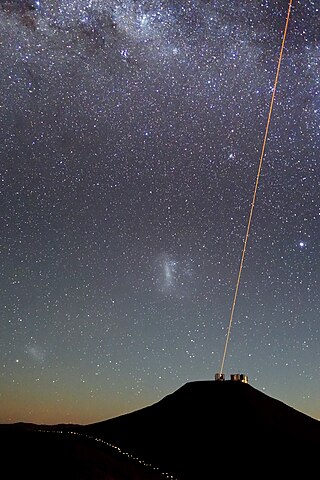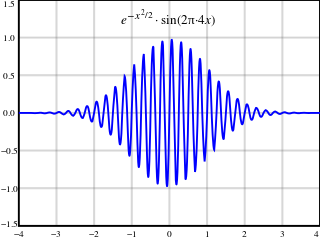Related Research Articles

Nonlinear optics (NLO) is the branch of optics that describes the behaviour of light in nonlinear media, that is, media in which the polarization density P responds non-linearly to the electric field E of the light. The non-linearity is typically observed only at very high light intensities (when the electric field of the light is >108 V/m and thus comparable to the atomic electric field of ~1011 V/m) such as those provided by lasers. Above the Schwinger limit, the vacuum itself is expected to become nonlinear. In nonlinear optics, the superposition principle no longer holds.
An electro–optic effect is a change in the optical properties of a material in response to an electric field that varies slowly compared with the frequency of light. The term encompasses a number of distinct phenomena, which can be subdivided into

An electro-optic modulator (EOM) is an optical device in which a signal-controlled element exhibiting an electro-optic effect is used to modulate a beam of light. The modulation may be imposed on the phase, frequency, amplitude, or polarization of the beam. Modulation bandwidths extending into the gigahertz range are possible with the use of laser-controlled modulators.

An optical amplifier is a device that amplifies an optical signal directly, without the need to first convert it to an electrical signal. An optical amplifier may be thought of as a laser without an optical cavity, or one in which feedback from the cavity is suppressed. Optical amplifiers are important in optical communication and laser physics. They are used as optical repeaters in the long distance fiber-optic cables which carry much of the world's telecommunication links.
In a single-mode optical fiber, the zero-dispersion wavelength is the wavelength or wavelengths at which material dispersion and waveguide dispersion cancel one another. In all silica-based optical fibers, minimum material dispersion occurs naturally at a wavelength of approximately 1300 nm. Single-mode fibers may be made of silica-based glasses containing dopants that shift the material-dispersion wavelength, and thus, the zero-dispersion wavelength, toward the minimum-loss window at approximately 1550 nm. The engineering tradeoff is a slight increase in the minimum attenuation coefficient. Such fiber is called dispersion-shifted fiber.
Mode locking is a technique in optics by which a laser can be made to produce pulses of light of extremely short duration, on the order of picoseconds (10−12 s) or femtoseconds (10−15 s). A laser operated in this way is sometimes referred to as a femtosecond laser, for example, in modern refractive surgery. The basis of the technique is to induce a fixed phase relationship between the longitudinal modes of the laser's resonant cavity. Constructive interference between these modes can cause the laser light to be produced as a train of pulses. The laser is then said to be "phase-locked" or "mode-locked".

Kerr-lens mode-locking (KLM) is a method of mode-locking lasers via the nonlinear optical Kerr effect. This method allows the generation of pulses of light with a duration as short as a few femtoseconds.

In optics, the Pockels effect, or Pockels electro-optic effect, is a directionally-dependent linear variation in the refractive index of an optical medium that occurs in response to the application of an electric field. It is named after the German physicist Friedrich Carl Alwin Pockels, who studied the effect in 1893. The non-linear counterpart, the Kerr effect, causes changes in the refractive index at a rate proportional to the square of the applied electric field. In optical media, the Pockels effect causes changes in birefringence that vary in proportion to the strength of the applied electric field.
The Kerr effect, also called the quadratic electro-optic (QEO) effect, is a change in the refractive index of a material in response to an applied electric field. The Kerr effect is distinct from the Pockels effect in that the induced index change for the Kerr effect is directly proportional to the square of the electric field instead of varying linearly with it. All materials show a Kerr effect, but certain liquids display it more strongly than others. The Kerr effect was discovered in 1875 by Scottish physicist John Kerr.

An optical parametric amplifier, abbreviated OPA, is a laser light source that emits light of variable wavelengths by an optical parametric amplification process. It is essentially the same as an optical parametric oscillator, but without the optical cavity.
Four-wave mixing (FWM) is an intermodulation phenomenon in nonlinear optics, whereby interactions between two or three wavelengths produce two or one new wavelengths. It is similar to the third-order intercept point in electrical systems. Four-wave mixing can be compared to the intermodulation distortion in standard electrical systems. It is a parametric nonlinear process, in that the energy of the incoming photons is conserved. FWM is a phase-sensitive process, in that the efficiency of the process is strongly affected by phase matching conditions.
Self-phase modulation (SPM) is a nonlinear optical effect of light–matter interaction. An ultrashort pulse of light, when travelling in a medium, will induce a varying refractive index of the medium due to the optical Kerr effect. This variation in refractive index will produce a phase shift in the pulse, leading to a change of the pulse's frequency spectrum.
This is a list of acronyms and other initialisms used in laser physics and laser applications.

A frequency comb or spectral comb is a spectrum made of discrete and regularly spaced spectral lines. In optics, a frequency comb can be generated by certain laser sources.
Silicon photonics is the study and application of photonic systems which use silicon as an optical medium. The silicon is usually patterned with sub-micrometre precision, into microphotonic components. These operate in the infrared, most commonly at the 1.55 micrometre wavelength used by most fiber optic telecommunication systems. The silicon typically lies on top of a layer of silica in what is known as silicon on insulator (SOI).

Self-focusing is a non-linear optical process induced by the change in refractive index of materials exposed to intense electromagnetic radiation. A medium whose refractive index increases with the electric field intensity acts as a focusing lens for an electromagnetic wave characterized by an initial transverse intensity gradient, as in a laser beam. The peak intensity of the self-focused region keeps increasing as the wave travels through the medium, until defocusing effects or medium damage interrupt this process. Self-focusing of light was discovered by Gurgen Askaryan.
The time-stretch analog-to-digital converter (TS-ADC), also known as the time-stretch enhanced recorder (TiSER), is an analog-to-digital converter (ADC) system that has the capability of digitizing very high bandwidth signals that cannot be captured by conventional electronic ADCs. Alternatively, it is also known as the photonic time-stretch (PTS) digitizer, since it uses an optical frontend. It relies on the process of time-stretch, which effectively slows down the analog signal in time before it can be digitized by a standard electronic ADC.
The Mamyshev 2R regenerator is an all-optical regenerator used in optical communications. In 1998, Pavel V. Mamyshev of Bell Labs proposed and patented the use of the self-phase modulation (SPM) for single channel optical pulse reshaping and re-amplification. More recent applications target the field of ultrashort high peak-power pulse generation.
In the fields of nonlinear optics and fluid dynamics, modulational instability or sideband instability is a phenomenon whereby deviations from a periodic waveform are reinforced by nonlinearity, leading to the generation of spectral-sidebands and the eventual breakup of the waveform into a train of pulses.
A parametric process is an optical process in which light interacts with matter in such a way as to leave the quantum state of the material unchanged. As a direct consequence of this there can be no net transfer of energy, momentum, or angular momentum between the optical field and the physical system. In contrast a non-parametric process is a process in which any part of the quantum state of the system changes.
References
- 1 2 Petrov, Nikolay V.; Sergei S. Nalegaev; Andrei V. Belashov; Igor A. Shevkunov; Sergei E. Putilin; Yu-Chih Lin; Chau-Jern Cheng (2018). "Time-resolved inline digital holography for the study of noncollinear degenerate phase modulation". Optics Letters. 43 (15): 3481. Bibcode:2018OptL...43.3481P. doi:10.1364/OL.43.003481. PMID 30067690. S2CID 51893588.